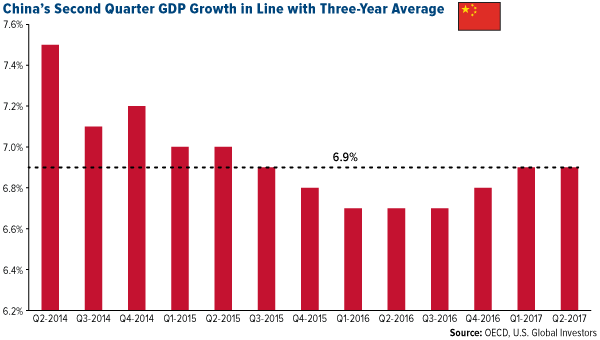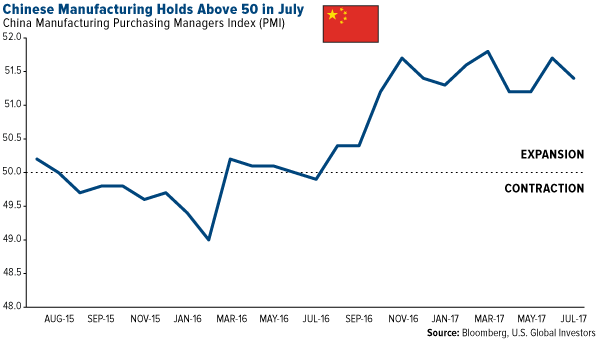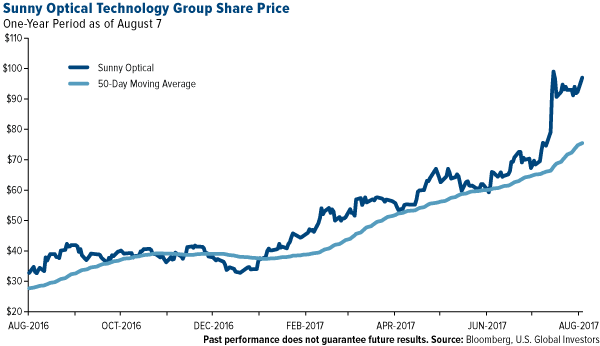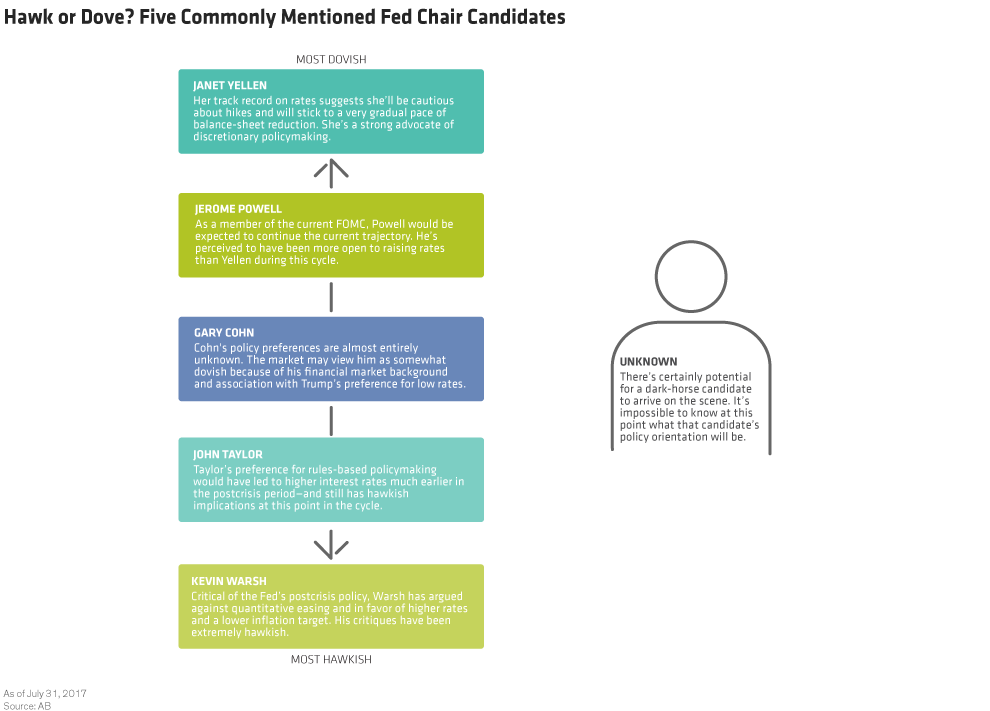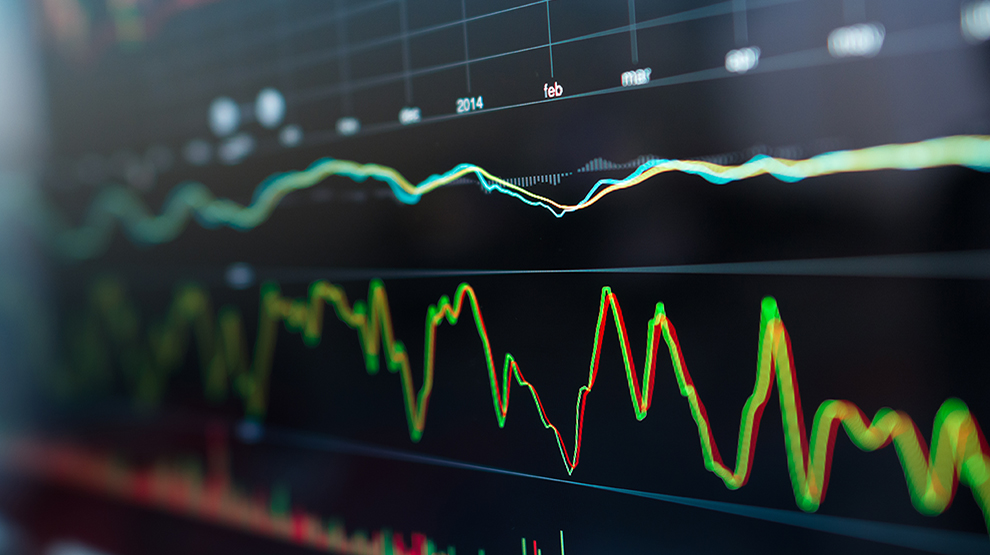by Frank Holmes, CIO, CEO, U.S. Global Investors
Share this page with your friends:
Please note: The Frank Talk articles listed below contain historical material. The data provided was current at the time of publication. For current information regarding any of the funds mentioned in these presentations, please visit the appropriate fund performance page.
August 9, 2017

I’m pleased to share with you that our China Region Fund (USCOX) beat its benchmark, the Hang Seng Composite Index (HSCI), by an impressive margin for the one-year, three-year and five-year periods, as of August 1. The fund has closely tracked the HSCI, but since late February of this year, it’s pulled sharply ahead.
There have been recent fears among economists and investors alike that China’s debt-fueled economy would contract as it transitions from old-school manufacturing to services, but the Asian giant has been far more resilient than most anticipated. Its gross domestic product (GDP) for the second quarter rose 6.9 percent over the same period last year, beating expectations and putting the country on track to meet the International Monetary Fund’s 2017 growth forecast of 6.5 percent.
June economic data was particularly robust. Services were among the main contributors to growth, rising 7.7 percent year-over-year. Industrial production accelerated 7.6 percent during the month. Exports rose 11.3 percent compared to June 2016, totaling nearly $200 billion.
China’s manufacturing industry also continued to expand, with the country’s official purchasing manager’s index (PMI) posting a 51.4 in July. While this is down slightly from June’s 51.7, it’s still above 50, indicating growth, and marks the 12th straight month of expansion.
This has all been a tailwind for USCOX, but we managed to beat the HSCI mainly by pivoting toward what I call China 2.0 and overweighting companies involved in high-tech industries. The second-largest economy has long fulfilled the role as the world’s top workhorse, producing biblical amounts of nearly every key resource, from cement to coal to steel. But lately, China has begun focusing its massive workforce and intellectual capital on advanced manufactured goods and services, which its own citizens demand more and more of as incomes rise.
This is where we see the most attractive opportunities for growth in China—not necessarily in the cement factories of Anhui Province but in the tech hubs of Shenzhen, Shanghai and Beijing.
China’s Rapid Digitalization
As the economic think tank Milken Institute wrote in September 2016, Shenzhen is “one of the pioneers in China’s new economy.” Not only is the city a fast-growing tech hub, but it’s also a “fertile ground for startup companies.”
The city is home to Chinese internet services provider Tencent, which surpassed Wells Fargo in April as the world’s 10th biggest company by value. It’s one of the largest holdings in USCOX and has been a top performer of 2017, up 70 percent year-to-date as of August 7.
The firm’s online payment system, Tenpay, has been a phenomenal revenue driver as China has steadily become the world’s largest e-commerce market, representing 42 percent of all online transactions globally as of 2016. That’s up remarkably from only 0.4 percent of all such transactions in 2005, according to management consulting firm McKinsey & Company.
It’s not hard to see what’s driving this rapid digitalization. Today’s China, with a relatively youthful median age of 37 and high urbanization rate, has 731 million internet-users—more than the U.S. and European Union combined. Since 2012, the country has been the world’s largest smartphone market, which has benefited companies such as Tencent.
It’s also been a tailwind for Chinese electronic components producers, Sunny Optical Technology Group among them. The research and development company is one of the largest cell phone camera module manufacturers in the world, but it also produces lenses for numerous other applications, including microscopes, drones, TVs, automobiles and more.
One of our top holdings in USCOX, Sunny Optical is up 185 percent year-to-date as of August 7. Its stock popped 17 percent on July 18 after the company reported net profit for the first half of the year was 120 percent over the same period in 2016.
Among other Chinese tech firms we like are BYD Electronic, TravelSky Technology and Apple-supplier AAC Technologies.
Autos Driving Fund Performance
Also driving fund performance were automobile manufacturers. As the number one auto market, China had a knockout 2016, with sales jumping 13.7 percent to 28 million units as consumers took advantage of the government’s tax cut on smaller-engine vehicles. The country registered more than 352,000 new electric vehicles in 2016, compared to only 159,000 in the U.S.
Sales slipped in the first quarter of this year as the tax cut was reduced, but they recovered in June, rising 2.3 percent compared to the same month last year.
Our two favorite Chinese auto names right now are Guangzhou and Geely Auto, the latter of which was our top holding in USCOX as of June 30. Geely, which bought Swedish car-manufacturer Volvo in 2010, is China’s largest non-government controlled automaker. July sales rose an amazing 88 percent compared to the same month last year, bringing the company’s market capitalization up to $22 billion. That’s about half of Ford Motors’ $43 billion market cap.
Year-to-date as of August 7, Geely shares are up more than 150 percent.
Old Economy Still Thriving
None of this is to suggest that China’s old economy, characterized by raw materials production and low-cost manufacturing, is disappearing any time very soon. The country cranked out a record amount of raw steel in June, with output rising to 73.23 million metric tons, a 5.7 percent increase over June 2016. Mill and smelter operators, responding to high steel prices, didn’t seem fazed by President Donald Trump’s threat to impose tariffs on Chinese steel, used in everything from cars to bridges to skyscrapers.
We’re focusing mostly on more advanced, high-tech industries, however, because that’s where we see the greatest opportunities for growth. The results, as you can see in the performance charts above, speak for themselves.
Please consider carefully a fund’s investment objectives, risks, charges and expenses. For this and other important information, obtain a fund prospectus by visiting www.usfunds.com or by calling 1-800-US-FUNDS (1-800-873-8637). Read it carefully before investing. Foreside Fund Services, LLC, Distributor. U.S. Global Investors is the investment adviser.
| One-Year | Five-Year | Ten-Year | Gross Expense Ratio | |
|---|---|---|---|---|
| China Region Fund | 33.80% | 7.01% | -0.35% | 2.76% |
| Hang Seng Composite Index | 28.24% | 9.43% | 4.60% | n/a |
Expense ratios as stated in the most recent prospectus. The Adviser of the China Region Fund has voluntarily limited total fund operating expenses (exclusive of acquired fund fees and expenses of 0.02%, extraordinary expenses, taxes, brokerage commissions and interest, and advisory fee performance adjustments) to not exceed 2.55%. With the voluntary expense waiver amount of 0.38%, total annual expenses after reimbursement were 2.36%. U.S. Global Investors, Inc. can modify or terminate the voluntary limit at any time, which may lower a fund’s yield or return. Performance data quoted above is historical. Past performance is no guarantee of future results. Results reflect the reinvestment of dividends and other earnings. For a portion of periods, the fund had expense limitations, without which returns would have been lower. Current performance may be higher or lower than the performance data quoted. The principal value and investment return of an investment will fluctuate so that your shares, when redeemed, may be worth more or less than their original cost. Performance does not include the effect of any direct fees described in the fund’s prospectus which, if applicable, would lower your total returns. Performance quoted for periods of one year or less is cumulative and not annualized. Obtain performance data current to the most recent month-end at www.usfunds.com or 1-800-US-FUNDS.
Foreign and emerging market investing involves special risks such as currency fluctuation and less public disclosure, as well as economic and political risk. By investing in a specific geographic region, a regional fund’s returns and share price may be more volatile than those of a less concentrated portfolio.
The Hang Seng Composite Index is a market-cap weighted index that covers about 95% of the total market capitalization of companies listed on the Main Board of the Hong Kong Stock Exchange.
The Purchasing Manager’s Index is an indicator of the economic health of the manufacturing sector. The PMI index is based on five major indicators: new orders, inventory levels, production, supplier deliveries and the employment environment.
Fund portfolios are actively managed, and holdings may change daily. Holdings are reported as of the most recent quarter-end. Holdings in the China Region Fund as a percentage of net assets as of 6/30/2017: Tencent Holdings Inc. 6.20%, Wells Fargo & Co. 0.00%, Sunny Optical Technology Group Co. Ltd. 6.75%, BYD Electronic Co. Ltd. 3.85%, TravelSky Technology Ltd. 3.34%, Apple Inc. 0.00%, AAC Technologies Holdings Inc. 3.00%, Guangzhou Automobile Group Co. Ltd. 4.63%, Geely Automobile Holdings Ltd. 8.96%, Ford Motor Co. 0.00%.
This post was originally published at Frank Talk.
Copyright © U.S. Global Investors






